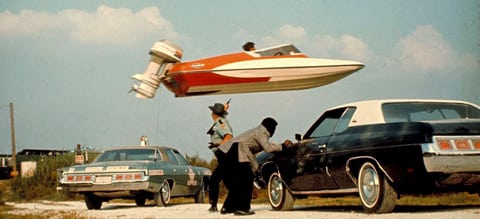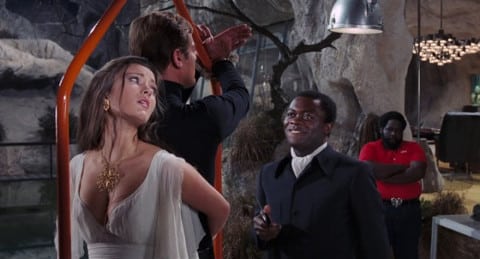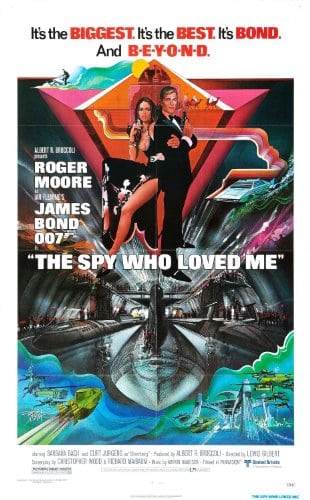Live and Let Die (1973)
Directed by: Guy Hamilton
Written by: Ian Fleming, Tom Mankiewicz
Starring: David Hedison, Jame Seymour, Roger Moore, Yaphet Kotto
UK
AVAILABLE ON BLU-RAY AND DVD
RUNNING TIME: 121 min
REVIEWED BY: Dr Lenera, Official HCF Critic
Three MI6 agents are killed under mysterious circumstances within 24 hours of each other in the United Nations, New Orleans and a Caribbean nation, San Monique, while monitoring the operations of the island’s dictator Dr. Kananga. James Bond is sent to New York City to investigate the first murder where Kananga also is, visiting the United Nations. Just after Bond arrives, his driver is shot dead and Bond is nearly killed in the ensuing car crash. A trace on the killer’s licence plate leads Bond to Mr. Big, a ruthless gangster who runs a chain of Fillet of Soul restaurants throughout the United States. There, Bond meets Solitaire, al tarot expert who can see both the future and remote events in the present. Escaping, Bond flies to San Monique, where he encounters Rosie Carver, a CIA agent….
Watching Live And Let Die – a film which has one foot in the Blaxsploitation pictures of the era – for the umpteenth time, it struck me how, if it came out today, there would probably a lot of complaining from those idiots who see racism everywhere, and how in fact it may not even get made today, bearing in mind how all the villains in it are black and how most – though not quite all – of the black characters are unsympathetic. For Roger Moore’s debut as a more lightweight 007, they seem to have, perhaps unsurprisingly, opted to use Dr. No as a template, from the opening sequence to Bond journeying to an island where the villain plays on native superstation – with a little help from modern technology – to keep people away, to Bond menaced in his room by a creepy crawly. They also decided to have a more low-key storyline, with the villain just a tawdry drug smuggler and little attempt at the usual gloss and spectacle. There’s hardly even any gadgets. And yet the film still comes off very well. While the humorous, light vibe of Diamonds Are Forever has been carried over, there’s also much more of a sense of menace to this film, which sometimes seems to be lurking on the edge of a much darker endeavour, though the second half though consists largely of comical chase sequences, which are full of crowd pleasing moments but have the actual tension and excitement diminish. There’s a slight schizophrenic quality [though not as much as Octopussy] about this fun, and yet overall it’s still highly inventive and amusing fun and considerably superior to Diamonds Are Forever.
Screenwriter Tom Mankiewicz used little of Ian Fleming’s novel except many character names and settings, and added even more humour when Moore got the part as Bond. His first introduction to Moore’s Bond, encountering another agent in a garden then jumping off what is revealed to be a skyscraper, was never shot. When Connery refused to return, Clint Eastwood was asked but turned the part down, and even Burt Reynolds, Paul Newman and Robert Redford were all considered. Julian Glover, John Gavin, Jeremy Brett, Simon Oates, John Ronane, and William Gaunt were tested, with Michael Billington the frontrunner, before Albert O’ Broccoli chose Moore, who had been considered in 1962 and 1969. Mankiewicz initially wrote Solitaire as a black woman to be played Diana Ross, but certain countries may have objected. As it was, Bond’s love scene with Rosie Carver was cut from the South African version. Desmond Llewelyn was written out of three episodes of the TV series Follyfoot so he could appear in the film, but to his annoyance found that he wasn’t in it. Bond’s intended first appearance, juming off a skyscraper with a villain, was removed from the script. Civil unrest prevented scenes from being filmed in Haiti, and they changed that particular setting to the ficticious San Monique and shot in Jamaica. There, the crew discovered a crocodile farm owned by a Ross Kananga, with the sign “trespassers will be eaten.” The farm was put into the script and the villain named Kananga, while Ross did the famous crocodile jump and on the fifth take had his trousers torn by a crocodile snapping at his heel. The Louisiana bayous and Harlem, where a local gang was paid protection money to ensure the crew’s safety, were also used. Moore cracked some teeth and twisted his knee when a boat he was in crashed into a boat house, while Dennis Edwards fainted when the snake supposed to kill his character was waved in front of him. Live And Let Die made more money than Diamonds And Forever, and despite middling reviews proved that Moore was immediately accepted as Bond.
For once we don’t see Bond at all in the pre-credits scene, which features three agents being killed. One is murdered via an electric shock through his ear pieceduring a conference, one is tied up and poisoned by a snake while natives dance about, and one, in one of the coolest moments of the film, is stabbed during a funeral procession where the “mourners” suddenly burst into dance as the band switches from a slow march to a lively dance. It’s so inspired and well executed [sorry]. Then we get a title song from Paul McCartney and Wings, which remains one of the best Bond songs ever, innovatively moving from a thoughtful ballad to hard rock to even a bit of reggae, and the start/stop nature of the piece cut very well to the first class credit sequence with the usual shadowed nudes accompanied by firebrands and skulls. Mankiewicz then does some interesting things in introducing the new 007, like having M and Miss Moneypenny visit Bond in his house [where of course he’s got a woman and has to hide her from M] to Bond being a bit of a fool [even the first card he picks from Solitaire is ‘The Fool’] as he blunders into Harlem sticking out very sorely indeed. Bond’s first meeting with Solitaire ends hilariously with, after Bond has picked a second card and it turns out to be – of course – ‘The Lovers’ – Bond calmly says to her: “Now promise you’ll stay right there, I shan’t be long” as he’s led away to be killed. It’s just so well played by Moore. Like him or loath him – and there was a time where it seemed to be cool to loath him – he puts his own stamp on the role very quickly.
The tensest moments of the film are quite early on, with Bond desperately trying to control a car where the driver has been killed, and a really quite bed-wetting moment with a snake in his hotel room. The voodoo aspect lurks around and threatens to make things really sinister, with the character of Baron Samedi a rather creepy presence who turns up unnervingly here and there. But once, in a very silly plot element, Bond takes away Solitaire’s powers by sleeping with her, it’s all chasing around, with a terrific collection of stunts to enjoy. Bond drives a bus under a low bridge so the top comes off, drives a wingless plane around an airport while cars crash all over the place, and drives a speedboat over a road and into a wedding cake. And there’s also that truly classic bit where Bond, trapped on a tiny island with crocodiles, runs over them to get to land. However, as entertaining as all this is, there’s little feeling of menace and the humour sometimes takes over. I always laugh at the redneck Sherriff J. W. Pepper desperately trying to stop the action going on his bayou, but in truth he’s out of place and more belongs in The Dukes Of Hazard or a Smokey And The Bandit film. And the final confrontations are almost over before they’ve begun. 007 does get another fight on a train, but it’s far inferior to his first, perhaps partly because we’re still missing editor Peter Hunt, and partly because – perhaps mindful of the story’s dark aspects – the filmmakers decided to really tone down the violence throughout.
There’s a concerted attempt to get away from the typical Bond film supervillainy and have more relevance, though this means that Kananga’s underground lair and monorail seem almost out of place in a film that goes for a more realistic look. It’s also painfully obvious that Mr. Big is Kananga with some latex on really early on and how Bond finds it to be a major revelation later on is bizarre. The character dies most memorably, ballooning and rising up to the ceiling with an air compression bullet shoved in his mouth, before exploding, though of course it just seems like an excuse for Bond to say: “He always did have an inflated impression of himself”. That’s the main flaw for me with these 70’s and sometimes these 80’s Bond’s – too many scenes are just set-ups for funny gags without being allowed to play through naturally – though I still tend to chuckle so I shouldn’t complain too much. Bond is still given some serious moments, though he really is a smarmy as well as a devious sod here, trying it on with Rosie Carver, the inept agent supposed to be helping him, within minutes of meeting her, and seducing Solitaire with, unknown to her, an entire deck of ‘The Lovers’ cards. And he’s genuinely unpleasant when he threatens to kill the treacherous Rosie and she pleads with him: “Not after what we’ve just done”. “Well I certainly wouldn’t have killed you before” is the cold reply. Mankiewicz has such a knack for one liners.
Mooree plays Bond just like he did The Saint and it suits the script perfectly. No, he’s not much like Connery, but aside from not being so convincing in the fight scenes [which aren’t too good anyway], that’s a good thing, he totally doing the part his way. Jane Seymour does okay with a potentially complex and fascinating character which is rather wasted by the screenplay. Yaphet Kotto as Kananga is mostly subdued which is fine as far as it goes but means that he’s upstaged by his aides: Julius Harris as the ever laughing Tee Hee who has one arm metal with a pincer for a hand, Earl Jolly Brown as the always whispering Whisper, and above all else Geoffery Holder as the very sinister Baron Samedi. We do at last get another good Felix Leiter in the form of David Hedison, the character at last feeling like Bond’s CIA equal. While one wonders what John Barry would have done with the score, George Martin’s score has a funky edge to it which works very well. He doesn’t use the title song very much, though bits of it do turn up, with the main theme really being another piece, a nice tune played over the first four notes of the James Bond theme [which are used throughout]. It’s good but overused in places, and some of the action could have done with scoring, but there are some good themes elsewhere and overall the score is pretty good and fits the film like a glove. Despite its few missteps, there’s still something extremely cool about Live And Let Die that makes it still seem quite fresh.










Be the first to comment